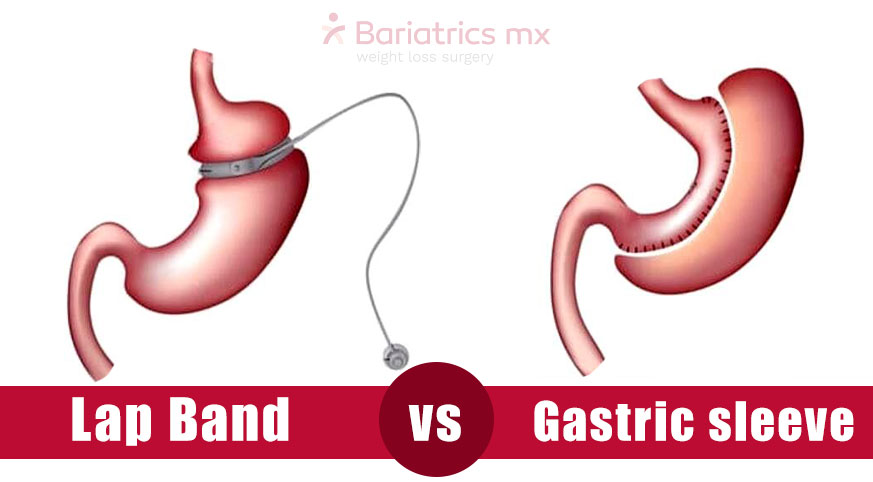What are Lap Band and Gastric Sleeve surgeries?
If you’re considering weight loss surgery, you’ve likely heard of both Lap Band and Gastric Sleeve procedures. These surgeries aim to help individuals lose weight by altering the way the stomach processes food, but they work in quite different ways. Let’s break down what each one involves and how they help you shed pounds.
The Lap Band surgery is designed to restrict the amount of food you can eat by placing an adjustable band around the upper part of your stomach. This creates a small pouch at the top, which means you’ll feel fuller after eating smaller amounts of food. The best part about the Lap Band is that it’s adjustable, and if you need more or less restriction, your doctor can tweak the band over time. It’s also a reversible procedure, so you have the option to remove it if things don’t go as planned.
On the other hand, the Gastric Sleeve surgery is a bit more permanent. It involves removing a significant portion of your stomach, leaving behind a smaller, sleeve-shaped organ. This procedure not only reduces the amount of food you can eat but also affects hormones related to hunger, helping you feel less hungry overall. Unlike the Lap Band, once your stomach is reduced, there’s no going back.
How do Lap Band and Gastric Sleeve surgeries differ?
While both surgeries aim to reduce food intake and help with weight loss, they go about it in different ways.
Procedure
The Lap Band is a relatively simple procedure where a band is placed around the stomach. It’s minimally invasive and adjustable, meaning the level of restriction can be changed as needed. In contrast, the Gastric Sleeve involves permanently removing a large portion of the stomach, which leads to more drastic changes in both food intake and appetite control.
Effectiveness
If you’re looking for faster, more significant weight loss, the Gastric Sleeve might be the better option. By reducing your stomach size and affecting your hunger hormones, it helps you lose weight consistently. However, the Lap Band tends to offer slower, more gradual weight loss, as it only restricts the amount of food you can eat without affecting your appetite directly.
Reversibility
This is where the Lap Band stands out. It’s an adjustable and reversible procedure, so if things aren’t working out, your doctor can adjust the band or even remove it altogether. The Gastric Sleeve, however, is permanent—once part of your stomach is removed, there’s no turning back.
Lifestyle
Both surgeries require a significant lifestyle change. The Lap Band offers some flexibility because it can be adjusted, but you’ll still need to maintain a healthy diet and exercise routine. The Gastric Sleeve, being permanent, may require even more commitment since your stomach size will always be smaller, and you’ll need to adjust your eating habits accordingly.
Benefits of Lap Band surgery
For many, the Lap Band is a great option because it offers a less drastic approach to weight loss. Here are some benefits that might make it the right choice for you:
- Adjustable and customizable: One of the main advantages of the Lap Band is that it’s adjustable. If you find that you’re not losing weight as quickly as you’d like, your doctor can tighten the band for more restriction. If you’re experiencing discomfort or complications, the band can be loosened, giving you more control over your progress.
- Lower risk of nutrient deficiencies: Since the Lap Band only restricts the stomach and doesn’t affect nutrient absorption, patients are generally less likely to suffer from deficiencies in vitamins and minerals. This can be a huge benefit compared to more invasive surgeries, like the Gastric Sleeve, which can make nutrient absorption more challenging.
- Minimal recovery time: Because the Lap Band surgery is less invasive than the Gastric Sleeve, you can expect a quicker recovery. Many patients can return to normal activities in just a few days. This can be especially appealing if you have a busy life and can’t afford to take weeks off for recovery.
- Reversible: Unlike the Gastric Sleeve, the Lap Band is not permanent. If you’re unsure about committing to a lifetime of smaller meals, this can offer peace of mind. The band can be removed or adjusted at any time, giving you more flexibility down the road.
Benefits of Gastric Sleeve surgery
While the Lap Band offers flexibility, the Gastric Sleeve is often the choice for those looking for a more permanent and significant weight loss solution. Here’s why:
- Faster weight loss: After a Gastric Sleeve, weight loss tends to be quicker and more consistent compared to the Lap Band. The permanent reduction in stomach size helps curb your appetite, making it easier to stick to a lower-calorie diet. Many people see faster results and greater long-term weight loss.
- Improved health outcomes: Aside from weight loss, the Gastric Sleeve can have a profound effect on your overall health. It has been shown to help with conditions like type 2 diabetes, high blood pressure, and sleep apnea, which are common among individuals with obesity. For many patients, it’s not just about losing weight—it’s about improving their quality of life.
- Permanent solution: For those who are committed to making a permanent change, the Gastric Sleeve offers a lasting solution. There’s no need for adjustments or maintenance, and the weight loss you achieve can be more consistent over time. It’s a “set it and forget it” approach that works for many.
- Better weight management: While both surgeries require lifestyle changes, the Gastric Sleeve gives you a permanent, reliable tool for managing your weight. By drastically reducing stomach size and appetite, it helps you make lasting changes without relying on constant adjustments like the Lap Band.
Which surgery offers faster results: Lap Band or Gastric Sleeve?
When comparing the speed of results, Gastric Sleeve surgery typically offers quicker and more substantial weight loss. This is because it permanently reduces the stomach size and alters hunger hormones, leading to a more immediate impact on your eating habits and weight loss.
The Lap Band, on the other hand, is a slower process. While it does restrict the amount of food you can eat, it doesn’t have the same hormonal impact, meaning it takes more time for results to become apparent. Also, the band needs to be adjusted over time, which can slow down the process.
Risks and complications of Lap Band surgery
Every surgery comes with risks, and the Lap Band is no exception. Some potential risks and complications include:
- Band slippage: The band can shift out of place, leading to symptoms like nausea, vomiting, or difficulty swallowing. If slippage occurs, further surgery may be necessary.
- Stomach stretching: Over time, the small pouch formed by the band may stretch, reducing the effectiveness of the surgery. This could lead to weight regain, and additional interventions may be needed to fix the issue.
- Port infection: The port, which is used to adjust the band, can sometimes become infected, requiring medical attention.
- Long-term maintenance: The Lap Band requires ongoing adjustments, which means more doctor visits. Some patients find this ongoing maintenance to be burdensome over time.
Risks and complications of Gastric Sleeve surgery
The Gastric Sleeve is generally safe, but it’s important to consider the potential risks:
- Nutritional deficiencies: Because the stomach is permanently reduced in size, the Gastric Sleeve can interfere with nutrient absorption. Patients may need to take supplements for the rest of their lives to prevent deficiencies.
- Leaks: In rare cases, there can be leaks from the staples used to seal the stomach. These leaks can lead to infection and may require further treatment.
- Irreversibility: One of the biggest considerations is that the Gastric Sleeve is permanent. Once part of your stomach is removed, there’s no going back.
- Post-surgical complications: As with any surgery, there are risks of infection, blood clots, and other complications.
Recovery and aftercare for Lap Band and Gastric Sleeve
Recovery time is an important consideration when choosing between these two surgeries.
- Lap Band recovery is typically quicker, with many patients resuming normal activities within a few days. However, the procedure requires frequent adjustments and follow-up visits, which can be time-consuming in the long run.
- Gastric Sleeve recovery takes longer due to the more invasive nature of the surgery. Most patients need a few weeks to fully recover, and the post-surgery diet is more restrictive as the stomach heals.
Costs of Lap Band vs Gastric Sleeve surgeries
When it comes to cost, Gastric Sleeve surgery tends to be more expensive initially. This is due to its complexity and longer recovery time. However, the Lap Band may end up costing more over time because of the need for adjustments and potential complications.
How to decide between Lap Band and Gastric Sleeve surgery
Deciding between the Lap Band and Gastric Sleeve comes down to your goals, health, and preferences.
- Lap Band might be the better option if you’re looking for a less permanent, adjustable solution.
- Gastric Sleeve may be the best choice if you’re committed to long-term weight loss and improving your health permanently.
Ultimately, it’s important to consult with a doctor who can help you weigh the pros and cons of each procedure based on your individual needs.









